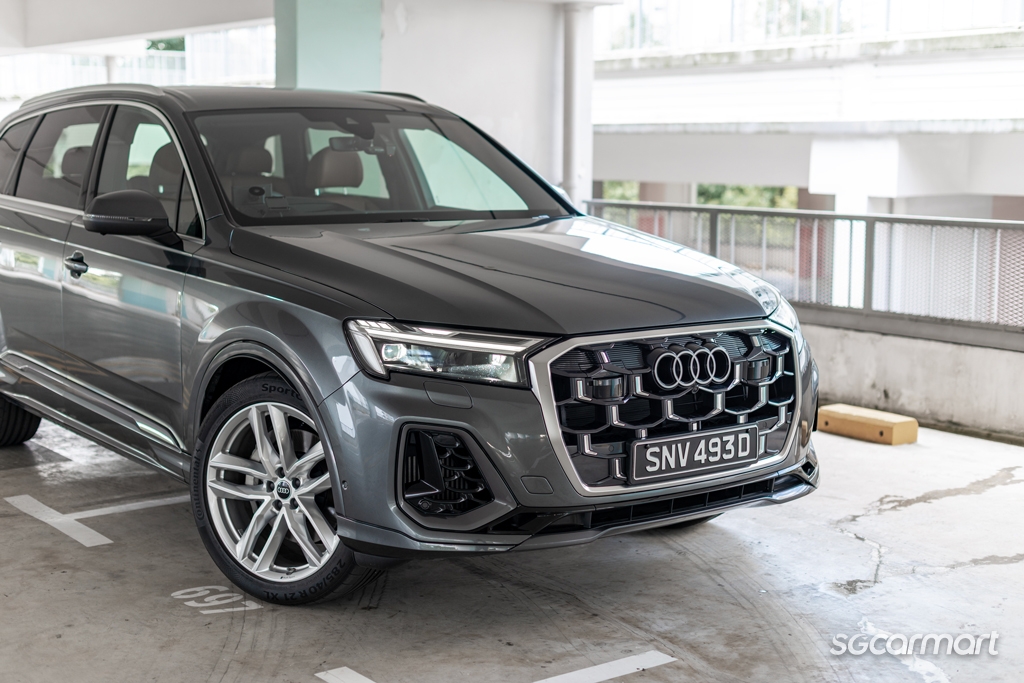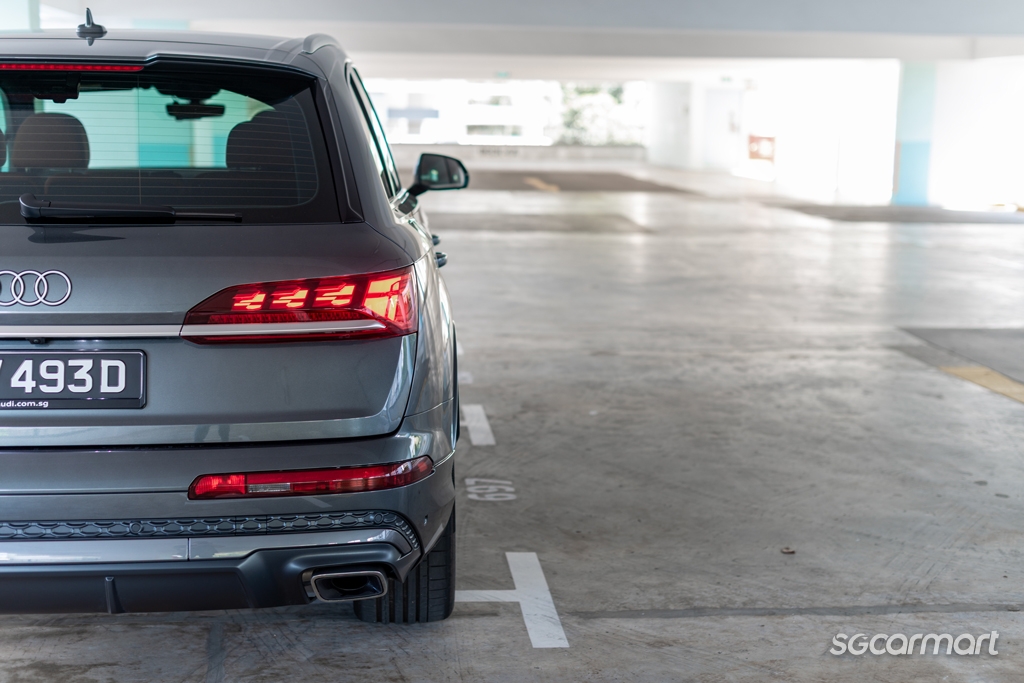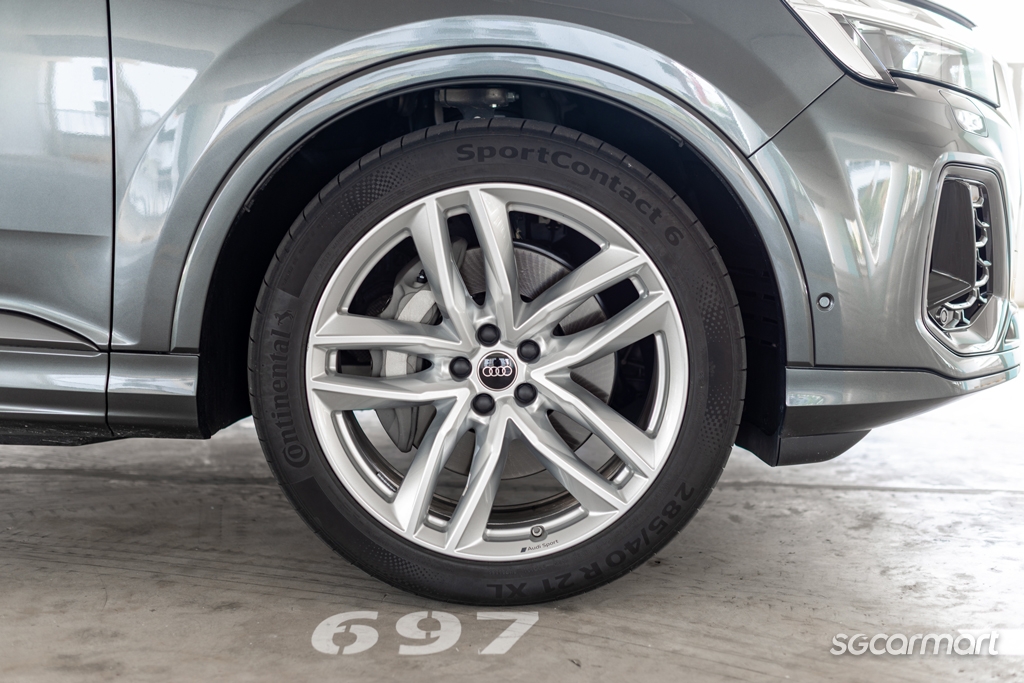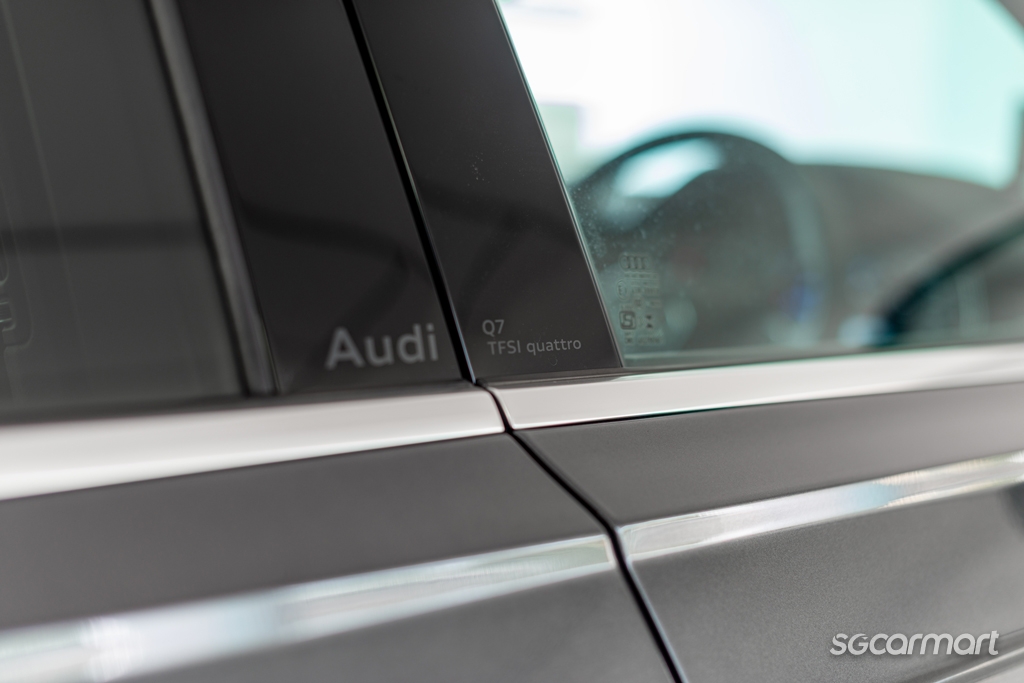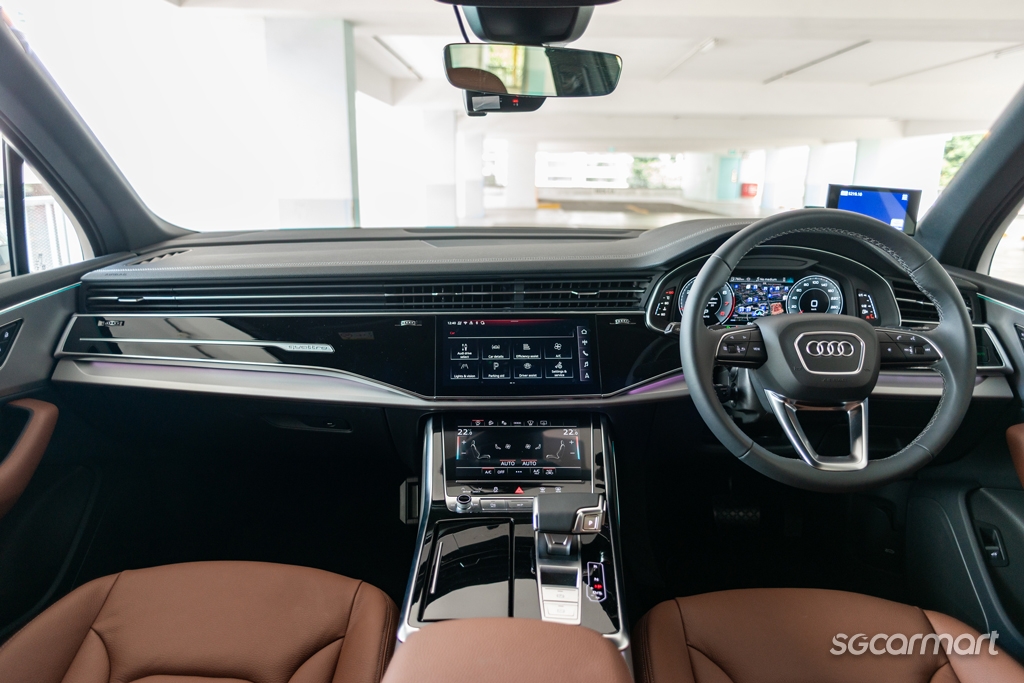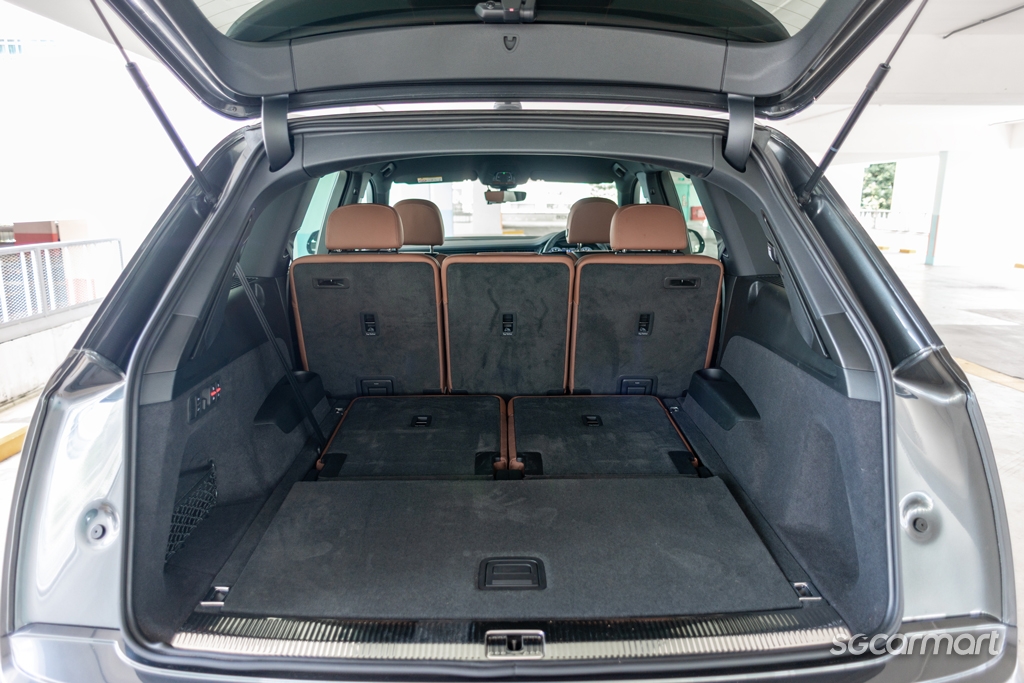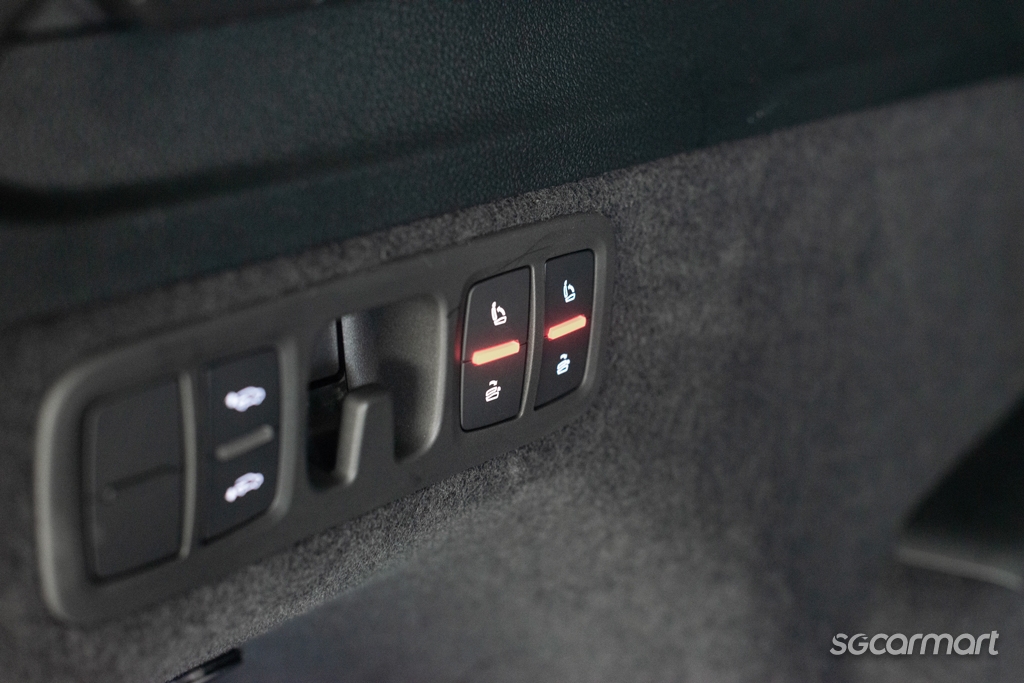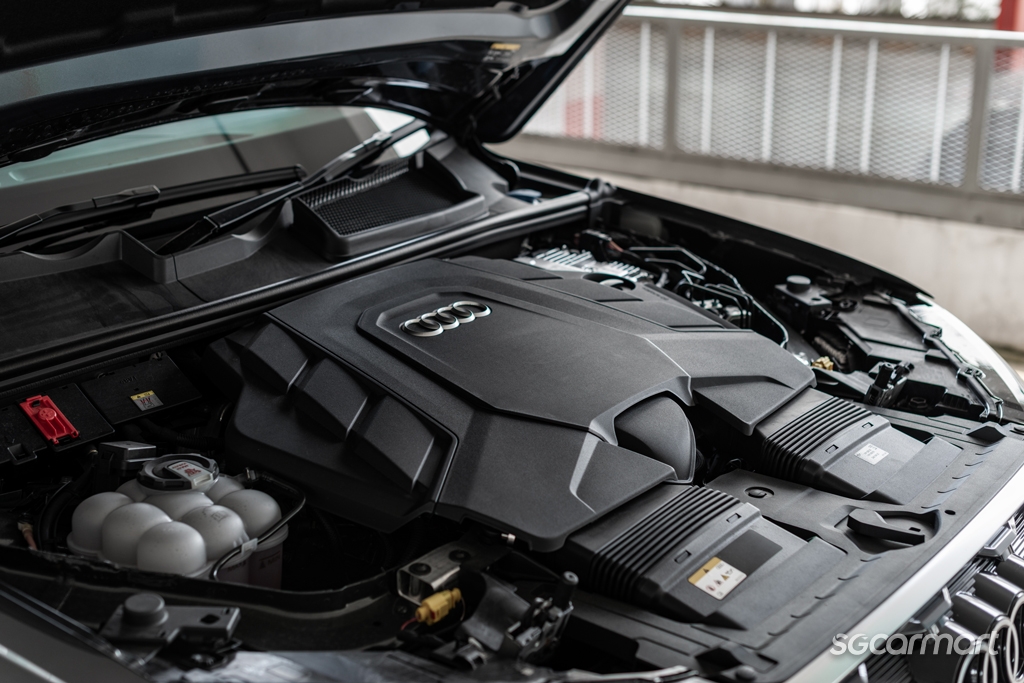Audi Q7 3.0 Mild Hybrid Facelift Review
09 Jun 2025|6,555 views
Facelift (What's New)
Redesigned front and rear
New Matrix LED head lights
OLED taillights
Enhanced virtual cockpit
Improved infotainment
'Imposing' is the first word that comes to mind when you walk up to an Audi Q7. The seven-seater SUV is 5,072mm long, 1970mm wide and 1,734mm tall - dimensions that some carparks struggle to accommodate.
Interestingly, it is also imposing because of its longevity: Despite Audi producing newer SUVs such as the Q8 e-tron, the Q7's continued presence as the flagship seven-seater lends it a cachet that fresher electric offerings lack.
That's why the Q7 is also chosen by captains of industry as an alternative to traditional limousines like the A8. It's an idea that Audi supports - after all, it sponsored vehicles for the film Fifty Shades of Grey, where protagonist Christian Grey is chauffeured in a Q7.
Older and somewhat bolder
Interestingly, despite being around for two decades, the Q7 only spans two generations. The progenitor was launched in 2005 and its successor followed in 2015. This was updated in 2019, and what you're seeing here is the second facelift of the second-generation model.
Perhaps this is why Audi made the Q7 look bolder by making the front end seem even more intimidating, with the new Matrix LED head lights giving the car a 'squint-ier' expression than before. The grille, which now has octagon-shaped elements, should have also been more elegant instead of resembling a cheese grater.
The 21-inch wheels add to the SUV's athletic character, while the subtle etched model names are a nice touch
Like other Audi models, the Q7 now has the model's name etched onto the window trim panels. OLED taillights make an appearance, too, and if you're into this sort of thing - these new units allow you to choose from several different light signatures.
Given its size, the Q7 has 21-inch wheels as standard (22-inch rims are optional), so even with some fender gap, it will never seem like the car has piano castors. The SUV's overall character is still one that is formidable and confident.
Consistency is key
There were no radical changes to the exterior so it's no surprise that the interior layout is largely untouched, too. A heads-up display is standard, along with Audi's virtual cockpit. The MMI and climate control touchscreens are carried over as well.
The changes are subtle. For instance, there is new grey contrast stitching on the upholstery, and customers now get a wider selection of decorative inlays that include Matte Carbon Twill, and Matte Brushed Aluminium with silver linear embossing, which is seen here.
The new shortcuts on the home screen are convenient, but Apple CarPlay now takes some time to load, even for a wired connection
Meanwhile, although the MMI system seems the same, there's now a store for apps, with users now able to directly use apps like Spotify. Virtual cockpit has been improved, for it now displays lane-change and distance warnings, and can show other road users as well.
Second-row accommodations are spacious and comfy, with plenty of legroom, plus another two climate zones to keep occupants happy. Complementing these are air vents on both the centre console and B-pillars to help everyone remain cool.
The rearmost seats, on the other hand, should only be used by children. Legroom is at a premium, and ingress and egress is also tricky. But at least the seats are electrically adjustable, with seatbacks that can be lowered and raised at a touch of a button. To facilitate loading and unloading the boot, users can lower the Q7's rear (thanks to the air suspension) as needed.
The third-row seats are easily folded with a touch of a button, and the rear end can be lowered to make loading/unloading easier
Flexing muscles
Motivating the Q7 is a turbocharged 3.0-litre V6 with a 48-volt mild hybrid system. It pumps out 335bhp and 500Nm of torque, with the latter figure available from 1,370rpm to 4,500rpm. The motor is paired to an eight-speed automatic gearbox.
This low-end torque is useful as the SUV's kerb weight is over 2.1 tonnes, resulting in substantial inertia that's palpable from a standstill. Even if you stab the accelerator pedal, it takes a moment for the powerplant to summon its performance figures.
The turbocharged V6 is proven and capable, and the eight-speed transmission delivers creamy gear changes
But once the boost comes on, the Q7 pulls like a freight train and zips from a standstill to 100km/h in 5.6 seconds. Its quick turn of speed managed to surprise not just other drivers, but some motorcyclists as well. Pile on the revs and you'll even be rewarded with a slightly throaty soundtrack.
Plush progress is the Q7's forte. With adaptive air suspension standard even on the 2.0-litre model, the Q7 irons out uneven surfaces and smoothens speed bumps. Active roll stabilisation is also present to stop the SUV from leaning too much if you corner quickly, but this doesn't make the Q7 handle like a small crossover.
With its linear character, quiet cabin and excellent ride quality, the Q7 was a relaxing drive to and from the office. The only noticeable (and expected) shortcoming was the high fuel consumption: Audi claims an average of 8.5km/L, but I only managed 6.3km/L in equal parts city and expressway conditions.
Still going strong
The Q7 doesn't have the wow or novelty factor of an all-new model. But what it lacks in flash, it makes up for with its continued appeal as a solid contender in the seven-seater luxury SUV segment.
Its cockpit isn't dominated by screens, but nobody will disagree with the convenience of physical controls, or the fact that the MMI system remains user-friendly because it's not bloated. And even if the powertrain isn't fully electric, both it and the ride quality are equally polished.
Perhaps the Q7 will eventually be replaced. But until that day arrives, this model's longevity as the brand's flagship seven-seater SUV and choice of captains of industry (even fictional ones like Mr Grey) will give it a cachet that its successor will need time to earn.
These reviews may also interest you
The Mercedes-Benz GLE450 keeps the luxury SUV segment in check with its imposing good looks, a well-appointed cabin and a high level of comfort and refinement
The SQ7, Audi's most powerful seven-seater SUV, defies all logic and reason. But that's exactly what makes it such a compelling drive
The Volvo EX90 Twin Motor Performance is the brand's flagship electric model, and it's unlike any Volvo you've ever driven
Facelift (What's New)
Redesigned front and rear
New Matrix LED head lights
OLED taillights
Enhanced virtual cockpit
Improved infotainment
'Imposing' is the first word that comes to mind when you walk up to an Audi Q7. The seven-seater SUV is 5,072mm long, 1970mm wide and 1,734mm tall - dimensions that some carparks struggle to accommodate.
Interestingly, it is also imposing because of its longevity: Despite Audi producing newer SUVs such as the Q8 e-tron, the Q7's continued presence as the flagship seven-seater lends it a cachet that fresher electric offerings lack.
That's why the Q7 is also chosen by captains of industry as an alternative to traditional limousines like the A8. It's an idea that Audi supports - after all, it sponsored vehicles for the film Fifty Shades of Grey, where protagonist Christian Grey is chauffeured in a Q7.
Older and somewhat bolder
Interestingly, despite being around for two decades, the Q7 only spans two generations. The progenitor was launched in 2005 and its successor followed in 2015. This was updated in 2019, and what you're seeing here is the second facelift of the second-generation model.
Perhaps this is why Audi made the Q7 look bolder by making the front end seem even more intimidating, with the new Matrix LED head lights giving the car a 'squint-ier' expression than before. The grille, which now has octagon-shaped elements, should have also been more elegant instead of resembling a cheese grater.
The 21-inch wheels add to the SUV's athletic character, while the subtle etched model names are a nice touch
Like other Audi models, the Q7 now has the model's name etched onto the window trim panels. OLED taillights make an appearance, too, and if you're into this sort of thing - these new units allow you to choose from several different light signatures.
Given its size, the Q7 has 21-inch wheels as standard (22-inch rims are optional), so even with some fender gap, it will never seem like the car has piano castors. The SUV's overall character is still one that is formidable and confident.
Consistency is key
There were no radical changes to the exterior so it's no surprise that the interior layout is largely untouched, too. A heads-up display is standard, along with Audi's virtual cockpit. The MMI and climate control touchscreens are carried over as well.
The changes are subtle. For instance, there is new grey contrast stitching on the upholstery, and customers now get a wider selection of decorative inlays that include Matte Carbon Twill, and Matte Brushed Aluminium with silver linear embossing, which is seen here.
The new shortcuts on the home screen are convenient, but Apple CarPlay now takes some time to load, even for a wired connection
Meanwhile, although the MMI system seems the same, there's now a store for apps, with users now able to directly use apps like Spotify. Virtual cockpit has been improved, for it now displays lane-change and distance warnings, and can show other road users as well.
Second-row accommodations are spacious and comfy, with plenty of legroom, plus another two climate zones to keep occupants happy. Complementing these are air vents on both the centre console and B-pillars to help everyone remain cool.
The rearmost seats, on the other hand, should only be used by children. Legroom is at a premium, and ingress and egress is also tricky. But at least the seats are electrically adjustable, with seatbacks that can be lowered and raised at a touch of a button. To facilitate loading and unloading the boot, users can lower the Q7's rear (thanks to the air suspension) as needed.
The third-row seats are easily folded with a touch of a button, and the rear end can be lowered to make loading/unloading easier
Flexing muscles
Motivating the Q7 is a turbocharged 3.0-litre V6 with a 48-volt mild hybrid system. It pumps out 335bhp and 500Nm of torque, with the latter figure available from 1,370rpm to 4,500rpm. The motor is paired to an eight-speed automatic gearbox.
This low-end torque is useful as the SUV's kerb weight is over 2.1 tonnes, resulting in substantial inertia that's palpable from a standstill. Even if you stab the accelerator pedal, it takes a moment for the powerplant to summon its performance figures.
The turbocharged V6 is proven and capable, and the eight-speed transmission delivers creamy gear changes
But once the boost comes on, the Q7 pulls like a freight train and zips from a standstill to 100km/h in 5.6 seconds. Its quick turn of speed managed to surprise not just other drivers, but some motorcyclists as well. Pile on the revs and you'll even be rewarded with a slightly throaty soundtrack.
Plush progress is the Q7's forte. With adaptive air suspension standard even on the 2.0-litre model, the Q7 irons out uneven surfaces and smoothens speed bumps. Active roll stabilisation is also present to stop the SUV from leaning too much if you corner quickly, but this doesn't make the Q7 handle like a small crossover.
With its linear character, quiet cabin and excellent ride quality, the Q7 was a relaxing drive to and from the office. The only noticeable (and expected) shortcoming was the high fuel consumption: Audi claims an average of 8.5km/L, but I only managed 6.3km/L in equal parts city and expressway conditions.
Still going strong
The Q7 doesn't have the wow or novelty factor of an all-new model. But what it lacks in flash, it makes up for with its continued appeal as a solid contender in the seven-seater luxury SUV segment.
Its cockpit isn't dominated by screens, but nobody will disagree with the convenience of physical controls, or the fact that the MMI system remains user-friendly because it's not bloated. And even if the powertrain isn't fully electric, both it and the ride quality are equally polished.
Perhaps the Q7 will eventually be replaced. But until that day arrives, this model's longevity as the brand's flagship seven-seater SUV and choice of captains of industry (even fictional ones like Mr Grey) will give it a cachet that its successor will need time to earn.
These reviews may also interest you
The Mercedes-Benz GLE450 keeps the luxury SUV segment in check with its imposing good looks, a well-appointed cabin and a high level of comfort and refinement
The SQ7, Audi's most powerful seven-seater SUV, defies all logic and reason. But that's exactly what makes it such a compelling drive
The Volvo EX90 Twin Motor Performance is the brand's flagship electric model, and it's unlike any Volvo you've ever driven
Also read our comparison article on:
Audi Q7 vs Mercedes-Benz GLE-ClassCar Information
Audi Q7 Mild Hybrid 3.0 TFSI qu Tip 7-Seater(A)
$487,999
CAT B|Petrol-Electric|8.5km/L
Horsepower
250kW (335 bhp)
Torque
500 Nm
Acceleration
5.6sec (0-100km /hr)
Thank You For Your Subscription.
- Older And Somewhat Bolder
- Consistency Is Key
- Flexing Muscles
- Still Going Strong
































































